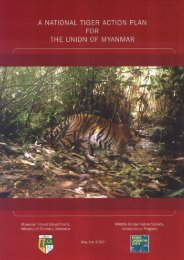Download - Global Tiger Initiative
Download - Global Tiger Initiative
Download - Global Tiger Initiative
You also want an ePaper? Increase the reach of your titles
YUMPU automatically turns print PDFs into web optimized ePapers that Google loves.
BACKGROUND AND INTRODUCTION<br />
The Snow Leopard Uncia uncia is an endangered “big cat” 1 , inhabiting the mountains of central<br />
Asia and the Himalayan region. For centuries, Snow Leopards have been valued for their long,<br />
thick fur and admired for their strength, elusiveness and ability to survive in harsh, high-altitude<br />
environments.<br />
Besides inspiring the myths and cultures of mountain communities, the Snow Leopard has also<br />
been exploited by humans. Historically, the demand for pelts and live animals for zoos may<br />
have had most impact on the species. A review of Snow Leopard skin exports from central Asia<br />
and Russia in the first two decades of the twentieth century put the annual world trade in Snow<br />
Leopard skins at 1000 a year (Heptner and Sludskii, 1972). Following concerns about the high<br />
numbers of skins in trade, especially during the 1960s, and lobbying by conservation groups,<br />
the International Fur Trade Federation (IFTF) recommended in 1971 that its members enter a<br />
moratorium on trade in <strong>Tiger</strong> Panthera tigris, Clouded Leopard Neofelis nebulosa and Snow<br />
Leopard skins and subscribe to a three-year ban on trade in Leopard Panthera pardus and<br />
Cheetah Acinonyx jubatus skins (Nowell and Jackson, 1996). Four years later, CITES, the<br />
Convention on International Trade in Endangered Species of Wild Fauna and Flora, entered into<br />
force and commercial trade in Snow Leopards and their body parts and derivatives has been<br />
prohibited since 1975, as a result of the species’s categorization in CITES Appendix I. World<br />
trade in spotted cat skins has decreased steadily since the mid-1970s: many consumers in the<br />
Western world no longer favours such furs, largely influenced by the ‘anti-fur campaigns’ by<br />
conservation groups in the 1980s.<br />
These initiatives and trends in the latter half of the twentieth century were to the benefit of Snow<br />
Leopard conservation but the killing of Snow Leopards in most parts of their range continued.<br />
In recent years, there have been reports of increased levels of Snow Leopard killings, especially<br />
in the Russian Federation and central Asia 2 (Koshkarev, 1994; Anon., 2002a; Dexel, 2002). In<br />
Kyrgyzstan, killings of Snow Leopards are said to have increased three- to four-fold since the<br />
early 1990s (Koshkarev, 1994), giving rise to concerns about how much longer local Snow<br />
Leopard populations can sustain such pressure. Motives for such killings vary. In some cases,<br />
trade and associated profit are the incentive; in other cases, Snow Leopards are killed because<br />
they are a nuisance to livestock herders but, whatever the reason, it is likely that the animal or<br />
its parts will ultimately enter trade. High prices are often paid for Snow Leopard skins and the<br />
bones, like those of other big cats, are used in traditional Asian medicines. While increased<br />
awareness of the threats facing <strong>Tiger</strong>s has undoubtedly benefited that species, emphasis on the<br />
<strong>Tiger</strong> alone may have shifted the trade to other big cats of equal conservation concern, such as<br />
the Snow Leopard.<br />
The following report was compiled with the aims of:<br />
•<br />
•<br />
providing a better insight into motives for killing Snow Leopards and subsequent trade in<br />
their body parts and<br />
assessing the scope and scale of this trade and its recent trends.<br />
The distribution, population and regulatory status of Snow Leopards in each range State are<br />
described and the different types of threat affecting the animals throughout their range are set<br />
FADING FOOTPRINTS: the killing and trade of Snow Leopards 1

















